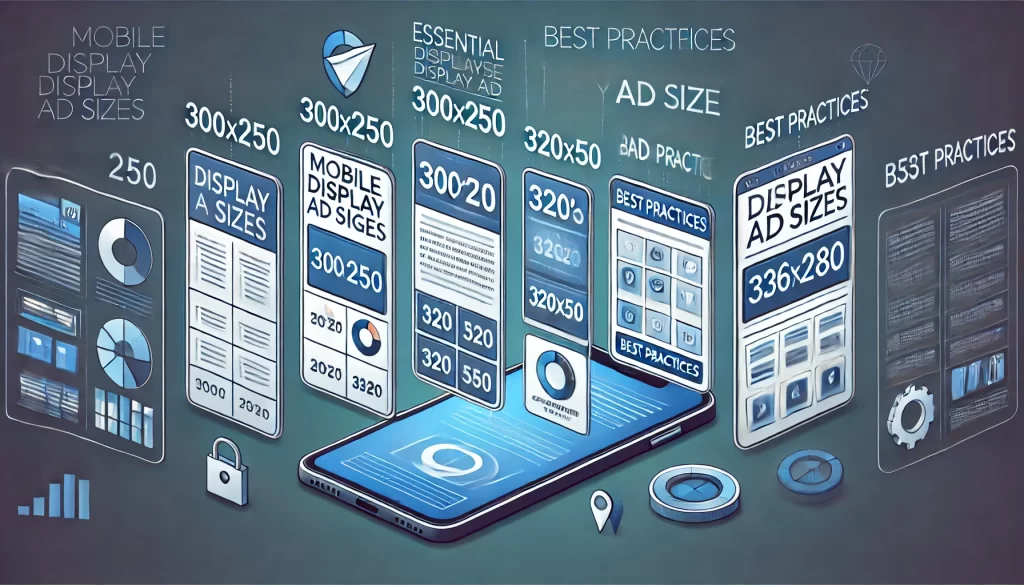Mobile display ads are an essential part of the modern digital marketing landscape. With the increasing use of smartphones, businesses are leveraging mobile advertising to reach audiences on-the-go. However, not all mobile display ads are created equal. The size of the ad plays a crucial role in its effectiveness, user experience, and overall engagement rates. In this article, we will dive into the world of mobile display ad sizes, providing you with an in-depth look at the best practices, key ad formats, and tips to optimize your mobile advertising strategy.

What Are Mobile Display Ad Sizes and Why Do They Matter?
Mobile display ad sizes refer to the pixel dimensions of advertisements shown on mobile devices like smartphones and tablets. These ads appear on various websites and mobile apps, designed to capture the attention of users. However, selecting the correct mobile display ad size isn’t as simple as picking a random dimension. The size determines the visibility, engagement, and performance of the ad.
The importance of mobile ad sizes can’t be overstated. With the vast number of ad formats and placements available, choosing the right size ensures that your ads display properly across different devices and screen sizes. Poorly optimized ads that don’t fit the screen properly or are too intrusive can lead to high bounce rates and a negative user experience. A well-sized ad, however, enhances visibility and engagement, driving better results for advertisers.
Related Posts
Overview of Popular Mobile Display Ad Sizes
There are several popular mobile display ad sizes, each suitable for different types of campaigns and platforms. Let’s break down the most common sizes and their typical placements:
Banner Ads
Dimensions: 320 x 50 pixels
Placement: Banner ads are one of the most commonly used ad formats. They typically appear at the top or bottom of the mobile screen in apps or websites. Due to their compact size, they are designed to be non-intrusive while still catching the user’s attention.
Interstitial Ads
Dimensions: 320 x 480 pixels, 300 x 250 pixels
Placement: Interstitial ads are full-screen ads that appear between content transitions. They are commonly used during app loading screens or between levels in mobile games. These ads provide more real estate for advertisers but can be intrusive if not implemented properly.
Native Ads
Dimensions: Varies based on content
Placement: Native ads are designed to blend seamlessly with the content of the page or app, making them appear as though they are part of the natural user experience. They can vary greatly in size, depending on the platform’s content layout.
Medium Rectangle (300×250)
Dimensions: 300 x 250 pixels
Placement: The 300 x 250 ad size is often used in both mobile websites and apps. It is versatile and fits well into sidebars or inline with content. These ads can also be displayed within content as “sponsored posts.”
Leaderboard Ads (728×90)
Dimensions: 728 x 90 pixels
Placement: While not as common on mobile, leaderboard ads can appear on larger mobile screens or tablets. They are typically placed at the top of the screen and are commonly used in mobile web-based platforms.
Square Ads (250×250)
Dimensions: 250 x 250 pixels
Placement: Square ads are often used in mobile websites and apps where space is limited. These ads can be placed within content feeds or at the bottom of the page.

Best Practices for Choosing Mobile Ad Sizes
Selecting the right mobile ad size is not a one-size-fits-all approach. It depends on your platform, target audience, and the type of ad campaign you’re running. Here are some best practices to follow when choosing mobile ad sizes:
Know Your Audience and Platform
Each mobile platform and audience has unique behaviors, so the ad size you choose should align with where your audience is most active. For instance:
- For Social Media Platforms (e.g., Facebook, Instagram): Native ads or smaller banner ads (e.g., 320 x 50 pixels) work well because they can integrate seamlessly with the content users are engaging with.
- For Mobile Apps or Game Ads: Interstitial ads (320 x 480 pixels) or medium rectangles (300 x 250 pixels) may be more suitable since they capture users’ full attention between levels or tasks.
- For Mobile Websites: The 300 x 250 medium rectangle ad or the 320 x 50 banner ad are great for smaller screen spaces, while the leaderboard can work well on tablet-sized screens.
Use Responsive Ads
Responsive ads are dynamic, meaning they automatically adjust to fit the screen size and format. This flexibility makes them a great option for ensuring your ads look good on any device. Responsive ads are especially important as mobile devices come in various sizes, from small smartphones to larger phablets and tablets.
Test and Optimize Ad Sizes
Run A/B tests with different ad sizes to understand which works best for your audience and campaign goals. Monitor performance metrics like click-through rates (CTR), conversion rates, and bounce rates to determine which ad sizes are driving the most engagement.
Responsive Ad Units and Dynamic Sizing
The role of responsive ads is critical in the mobile ad space. Since there are so many screen sizes and devices, responsive ads ensure that your advertisements are adaptable to various formats and screen dimensions. They automatically adjust to the available space, whether it’s on a smartphone, tablet, or phablet.
Dynamic sizing involves using technology that adjusts the size of the ad based on the device being used. For example, an ad might show up as a banner on a small phone but adjust into a medium rectangle on a larger tablet. This ensures that your ad maintains its effectiveness regardless of the user’s screen size.
Impact of Mobile Display Ads on User Experience
While the goal of mobile display ads is to drive engagement and conversions, it’s crucial to consider how they affect the user experience. Poorly placed or overly intrusive ads can lead to a negative user experience and may result in high bounce rates.
Balancing Ad Visibility with User Experience
Finding the right balance between visibility and user experience is key. You don’t want ads to be too intrusive, but you also don’t want them to be so small that they’re overlooked. Optimizing your mobile display ad sizes ensures that the ads are visible but not overwhelming, leading to a more positive interaction with your content.
Real-World Examples of Good vs. Bad Ad Placements
- Good Example: A banner ad (320 x 50 pixels) placed at the top of a mobile webpage, clearly visible but unobtrusive, enhances the user experience without disrupting content consumption.
- Bad Example: A full-screen interstitial ad that loads before the user can access the content, forcing them to wait for a close button, may frustrate users and lead to higher bounce rates.
Key Takeaways
Choosing the right mobile display ad sizes is vital for optimizing user engagement and ensuring a positive experience across different devices. By considering platform types, audience behavior, and using responsive or dynamic ads, marketers can create mobile ad campaigns that are both visually appealing and effective. Remember to test different ad sizes and monitor performance to determine which dimensions provide the best results for your campaigns.
- Mobile ad sizes matter: Selecting the right ad dimensions enhances visibility and engagement while ensuring ads don’t disrupt the user experience.
- Popular ad sizes include banner ads (320×50), interstitials (320×480), native ads, and medium rectangles (300×250).
- Responsive ads automatically adjust to different screen sizes, ensuring optimal visibility on various devices.
- Balance is key: Prioritize user experience by choosing ad sizes that offer high visibility without being intrusive.
FAQs
What is the best mobile display ad size for small screens?
The 320 x 50 banner ad is the most commonly used ad size for small screens, as it offers a good balance between visibility and non-intrusiveness.
How do responsive ads work?
Responsive ads dynamically adjust their size and format depending on the screen size of the device they are being viewed on, ensuring they display correctly on smartphones, tablets, and phablets.
What is the most effective mobile ad format?
The most effective mobile ad format depends on the platform and target audience, but generally, banner ads, interstitials, and native ads tend to perform well across mobile websites and apps.
How can I ensure my mobile ads do not affect user experience negatively?
Avoid overly intrusive formats like full-screen interstitials that disrupt user navigation. Use appropriate ad sizes for the device and test the placement to ensure it complements the content.
Why should I test different mobile ad sizes?
Testing different ad sizes helps you understand which dimensions provide the highest engagement and conversion rates for your target audience.
What are interstitial ads and when should they be used?
Interstitial ads are full-screen ads that appear between content transitions. These are most effective for app-based advertising and mobile games.
